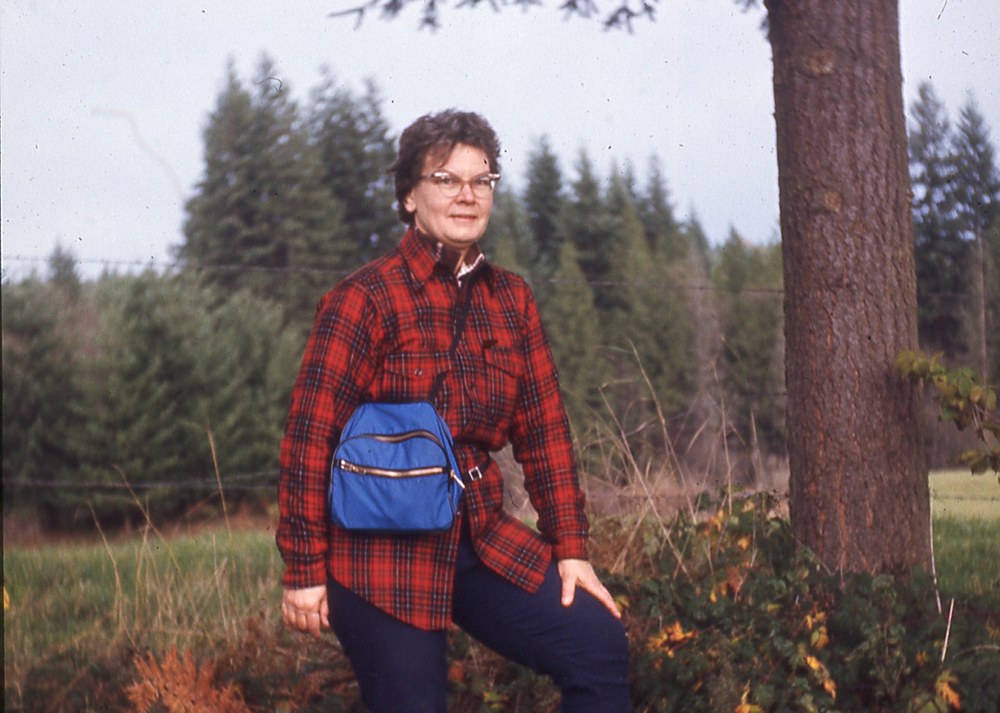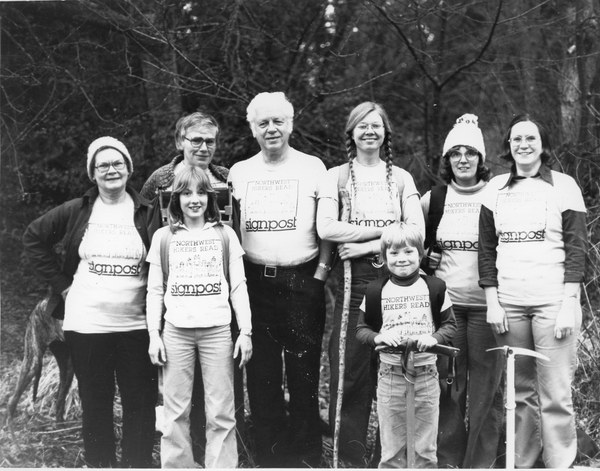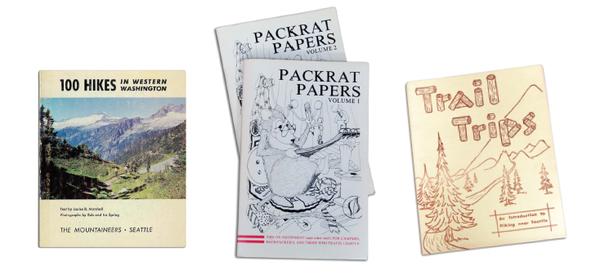
An avid hiker, community organizer, and Mountaineers member, Louise Marshall was a passionate outdoorswoman and a key figure in Washington’s history. As a young woman I not only had the opportunity to meet Louise and hike with her, but reaped the benefits of all that she brought to the hiking community and the broader Washington outdoors community. I am excited to share with you the trials, tribulations, and triumphs that Louise experienced as a pioneer in the outdoor industry.
Louise Marshall was born in Boston in 1915, into a family that held the unusual perspective that physical education was key for girls. Her father was a physician who valued outdoor recreation, and so she spent her summers in the birch-filled forests of New England horseback riding, canoeing, hiking, and backpacking. As she entered young adulthood, Louise earned her Master’s Degree in physical education, then spent several summers in her early 20s bicycling across Europe. Imminent war kept her at home in 1939 and prompted her to join a local outdoor club, where she met her adventure partner and eventual husband Bill Marshall.
The couple moved to Seattle several years later, settling in a rural unincorporated area north of the city in 1952. They joined The Mountaineers seeking local information on how to access the outdoors. Although many hike leaders had information on local trails, they were hesitant to share the information with newcomers from New York. Undaunted, Louise volunteered to serve as a hike leader herself, and her file on trail information rapidly filled. By the mid-1960s she had enough to write a guidebook. Inspired by European guidebooks she had fallen in love with, Louise embarked on this new effort.
A guidebook author
Out of this was the birth of Trail Trips: An Introduction to Hiking Near Seattle. Her book was among the first guides in the region and was a tool sorely needed in the area. Unable to find a publisher, Louise typed the manuscript herself and had a few copies printed. When she realized the need for up-to-date trail information in 1966, she began publishing a weekly mimeographed newsletter, Signpost, churning it out every Sunday with an ancient duplicator machine. Louise enlisted the help of her two teenage daughters and hand-published the newsletter on the dining room table of their farmhouse.
Although initially designed for Mountaineers hike leaders, the publication quickly caught on in the broader outdoor community. Louise soon found herself printing copies and mailing them to any interested party. I remember receiving the first few copies; having access to current information on trail conditions, accessibility, and road status was a new concept to local hikers. We were astonished and delighted that Louise had been able to do this by herself. The information offered in Signpost introduced us to trails we hadn’t thought of hiking and allowed us to explore the area in new ways.
Still considering the need for a published guidebook, Louise wrote a more detailed guide on trails near Seattle. The Mountaineers volunteer-led Literary Fund Committee had been considering something similar, and photographer Ira Spring was willing to take the photos. Louise’s proposal came at just the right time: she chose 100 of her favorite trails and the guidebook 100 Hikes in Western Washington was born. According to Ira, the all-male committee said, “She’ll do; although she doesn’t know much about trails, at least she can write.”

In the early 1980s Louise had t-shirts designed for Signpost subscribers. The entire Signpost staff posed for a promotion photo. Back row: Louise, Ruth and Carl Munson,Janet Garner, Ann Marshall, Plum Moore. Front row: Amber Stagg and Marshall Stagg, two of Louise's grandchildren who frequently helped around the office.
The guidebook was enormously popular, with the first printing selling out in weeks. Reprints required updates and corrections, and Louise always had a file at the ready. When she heard that The Mountaineers Literary Fund Committee planned to start a series of hiking guidebooks for other regions of the state, she assumed she would be asked to write them. However, the committee chose local author, conservation activist, and hiker Harvey Manning instead. Louise was never explicitly told why she was passed over to continue the series she had helped start; neither the committee volunteers nor Ira Spring would discuss it. Louise felt she couldn’t compete with Harvey Manning, a beloved climbing course leader who had authored the first edition of Mountaineering: The Freedom of the Hills and had the volunteer committee standing behind him. She believed she was penalized for being relatively new to the Northwest and a woman, and this bothered her for many years. She later said to her daughter Ann, “I can’t worry about it anymore. It’s in God’s hands and I’ll get my reward in heaven.” (Ann has said that she never knew what to make of that remark, as her mother was an atheist.)
The 100 Hikes guidebook series went on to become a well-known Harvey Manning and Ira Spring joint enterprise, eventually encompassing guidebooks for the North Cascades, Glacier Peak region, Mount Rainier, South Cascades, and the Olympics. Louise went on to write three more guidebooks, all self-published.
An environmental activist
Throughout this time Louise continued her outdoor pursuits, never seeming to tire on-trail. She spent her weekends hiking and took long trips with the family dog into the backcountry every summer. She worked on updates to one of her guidebooks, a Pacific Crest Trail book entitled High Trails, and spent weeks hiking the trail from the Canadian border to the Columbia River, often on Mountaineers trips and sometimes alone.
Louise also continued in her efforts with Signpost, and as the newsletter developed so did its message and purpose. Conservation, stewardship, and local activism became priorities along with trail information, and the newsletter was utilized to tell readers how to advocate for our public lands. Signpost-organized work parties began to be listed in 1972, and a culture of volunteerism started to develop.

A few of Louise's hiking guides: 100 Hikes in Western Washington, the Packrat Papers Volume 1 & 2, and Trail Trips: an Introduction to Hiking near Seattle.
One large win came in 1980, when the newsletter was used to call on hikers to protest the Department of Natural Resources’ plan to conduct a timber sale along Ashland Ridge in the Sultan-Pilchuck Recreation Area. Their proposal involved the introduction of new roads, a large bridge, and the destruction of many of the hiking trails near the Ashland Lakes. The efforts made by Louise and the dedicated Signpost readers were successful, and the department cancelled their original timber sale. It was through this success and several others that the idea of formalizing a conservation and stewardship-oriented organization developed. Fourteen years after its inception, Signpost magazine became the nonprofit Signpost Trails Association, which officially became the Washington Trails Association (WTA) in 1985. WTA then went on to establish its signature trail maintenance program in 1993, carrying on Louise’s legacy as an environmental steward.
But before these sweeping changes took place, Louise kept herself constantly busy over the years, organizing trail maintenance work parties and establishing hiking groups. She started a local housewives’ hiking group in the late 1960s, called the Happy Hikers. Located in South Snohomish County, it’s through the Happy Hikers that I had the opportunity to meet and get to know Louise as we hiked together. I always enjoyed our brisk midweek walks on a rural county road, finishing in time to get back before my kids came home from school. Once again, she had anticipated a need and filled it.
Pioneering national advocate
As she grew more interested in nation-wide advocacy efforts, Louise took advantage of her husband’s airline employee flight privileges and often flew to Washington D.C. to advocate on behalf of our trails to officials in the National Park Service and U.S. Forest Service. She also cofounded the American Hiking Society, serving as President and Chairman of the Board from 1986–89. As these efforts grew she helped the Washington Trails Association become a political force, with the advocacy arm of the organization taking on controversial issues of the day. Louise gradually turned the institution over to a competent board of directors, planning for the day when she would no longer be here.
In addition to her guidebooks, newsletter publication, and cofounding of both WTA and the American Hiking Society, Louise was the first woman to be elected to REI’s Board of Directors. At various times she was president, executive director, board member, and newsletter publisher at the Pacific Crest Trail Association. In 1996 she received the PCTA’s Lifetime Achievement Award.
She was never a mountain climber, but Louise believed it was important to save public lands, keeping them wild and limiting our impact. She loved to feel the breath of cold wind coming off a snowfield or glacier. She enjoyed traveling under her own power, and the feeling of self-reliance she got from long backpacking trips into the mountain wilderness.
The last time I saw Louise, she was using a walker. Her daughter Ann was stepping down as editor of the magazine Pack & Paddle, and had scheduled a farewell party. I had hiked with both women and kayaked and canoed with Ann. I respected their strength and expertise. I told them how grateful I was for all they had contributed.
Louise asked what I had been up to, and when I said I had recently gone backpacking, she responded, “I am so jealous. Sit down, and tell me all about it.”
Louise Marshall died in 2005 at the age of 90. Her legacy continues today with the strength and influence of all that she created, and the communities that formed around her work. We thank Louise for her tireless work championing our trails, seeking equality, and breaking ground on and off-trail.
Joan Burton is a 69-year member, lifelong outdoorswoman, and the author of the Mountaineers Books editions of Best Hikes with Kids: Western Washington & the Cascades. Joan is currently writing Early Women Climbers, Conservationists and Chroniclers in the Pacific Northwest, in which Louise Marshall will be one of her subjects. Today our publishing division, Mountaineers Books, is run by a professional publishing staff who has strived to bring more women’s voices to the outdoors through numerous guidebooks, narratives, and photography projects.
This article originally appeared in our Fall 2020 issue of Mountaineer Magazine. To view the original article in magazine form and read more stories from our publication, visit our magazine archive.
 Joan Burton
Joan Burton